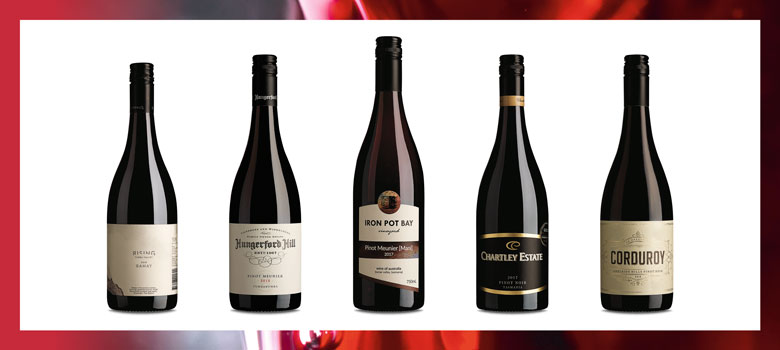
Wine
State of Play: Lighter Reds
Something exciting has been happening in the Australian wine landscape in recent years. And I'm not one to normally get excited, but this is big, really big. What we have been witnessing in this country in only the last 15 years, is the gradual evolution in red wine consumption from rich, powerful and highly alcoholic wines, to more elegant and subtle, easy-drinking styles. The market has shifted forever with more choice and complexity across Australian red wine styles.
From the 1960s, our industry survived for three decades on the all-important red varieties of Shiraz and Cabernet Sauvignon. These wines were crucial to the success of our winemakers – consumers loved the rich, concentrated, oaky and alcoholic wines. The more oak and alcohol, the better, and the Barossa and McLaren Vale regions couldn’t make enough of it. And if the wine didn’t have 14.5% alcohol on the back label, there was something wrong with it!
This situation was exacerbated when exports became the focus and huge volumes of wine were being shipped to the UK and USA. Influential American wine writer Robert Parker fell in love with our rich, robust reds. He was one of the first to score wines out of 100 points, and when our big Aussie Shiraz starting scoring 95 points and more, the flood gates opened and winemakers all over the country were trying to outdo each other with the oakiest and highest alcohol wines they could possibly produce. Of course, the notion of making wine styles for wine writers, however influential, is absurd, but sadly, this mostly flawed ideology drove our red wine production for many years.
change in the air
As we entered a new century, consumers were waking up to the idea that ‘big’ was not always better. More discerning buyers began to notice a ‘sameness’ to all of our red wines, especially our most celebrated variety, Shiraz. Apart from the cooler climate wines, most Aussie Shiraz and Grenache, and to a lesser extent Cabernet, tasted the same. Across our vast wine regions with all the different micro climates, there was no terroir. In short, we were getting bored with drinking the same-tasting red wines!
About the same time, major retailers as well as wine importers realised there was an opportunity and interest in Australia, for imported wines. We began to see what the rest of the wine world was offering. Previously unheard of varieties such as Gamay, Dolcetto, Nero d’Avola, Sangiovese and Tempranillo from France, Italy and Spain were slowly gaining interest and Australian consumers loved them. They were different, they were exciting. They complemented food rather than overpowering it. A new trend in red wine consumption was taking shape.
Jeremy Dineen, Chief Winemaker at Josef Chromy states, “I’ve almost always made Pinot Noir, not only because it’s the most suited red variety to grow in the Tasmanian climate, but because I love the freshness and drinkability of lighter reds and Pinot can give layers of complexity and texture.
"While I was studying winemaking at uni, Pinot was considered by many to be ‘not a real red wine’ as it didn’t have the deep colour or the high tannin levels of Shiraz and Cabernet. Ironically, many of my colleagues and friends who now grow and make those varieties in regions like the Barossa, McLaren Vale, Hunter Valley or Margaret River now drink a lot of Pinot Noir. I think Pinot, Grenache, Gamay and some of the lighter style Italian and Spanish varieties suit our climate and lifestyle much more than the traditional full-bodied reds.”
new directions
Today's consumer is more sophisticated and demanding. We want choices. The health conscious drinker has also had an impact on the growth of lighter style reds. Most of our Pinot Noirs, for example, are easier to drink than your typical Shiraz or Cabernet Sauvignon, complement many more foods, but importantly are quite a bit lower in alcohol, which is what many people desire these days. Our climate is having a big influence on what reds people are drinking, particularly in summer. I'm loathe to open a full-bodied Shiraz on a warm day, preferring a lighter Pinot or modern style Grenache, and I’ll pop it in the fridge for a half hour before opening, to take the edge off it.
So what are the best light dry reds we have tasted recently? They represent a new generation of varieties being planted across the country. Winemakers have embraced lighter styles and consumers are getting the chance to taste them from many regions. We know Pinot Noir has been growing its market share for well over a decade now, but I'm excited about lots of other varieties such as Gamay, Grenache, Cabernet Franc, Sangiovese, Pinot Meunier and Nero d’Avola.
Many winemakers are also persisting with traditional varieties, but making these wines in a different way – lighter and more approachable. While the cool climate regions seem to be the obvious go-to for lighter style reds, it's fair to say that even traditional regions such as the Barossa have embraced the trend towards lighter styles. Grenache is the perfect example of wine from the Barossa that was traditionally rich and oaky, but these days is made in a lighter style, with grapes picked earlier, toning down the oak and making what I describe as easier drinking or ‘smashable’ wines.
Wayne Ahrens, winemaker at Smallfry Wines in the Barossa, labels some of his wines as ‘Joven’ and explains, “I spent a fantastic year living in Spain in my youth and the chance to try my own interpretation of this classic style gives me a thrill. In the Barossa in 2017, we picked the Tempranillo quite early to capture some sour red cherry/cranberry characters, which in my mind are the perfect foil for some lovely old bush vine Garnacha. Monastrell, Bastardo and Tinta Amerilla fill out the back palate, but the main focus of this wine is juicy red fruits and bright flavours. This is a great food wine for matching with today's fresh flavours. Like a red wine with your chicken or fish? This is it.”
The popularity and growth of lighter style red wines is a fantastic development for Australian wines. While I will always have Shiraz from the Barossa and the Hunter Valley in my cellar, these days I'm buying more of the fresh, juicy fruit driven styles like those featured here. When it comes to red wine, the future is certainly bright...and light!
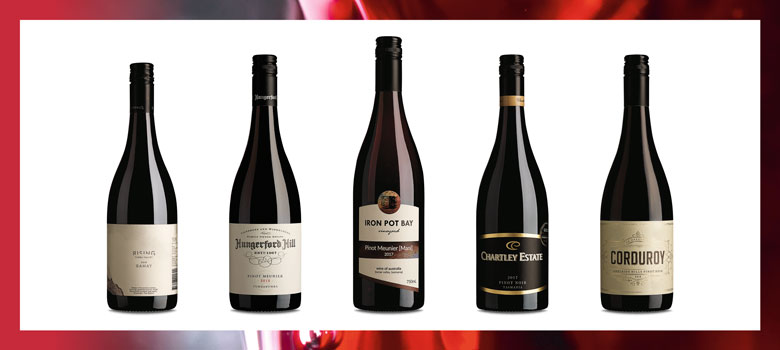
Rising Gamay 2018
Yarra Valley, RRP $30
“A new expression of the Yarra Valley,” Rising is a single vineyard brand from the team at Sticks. Winemaker Tom Belford has a great love for Gamay, and he describes the 2018 vintage as, “convivial, generous and fun.” The Panel were equally enamoured, calling
it a bright Beaujolais style with satiny and jubey flavour drive and long red cherry and white mushroom flavours over a gentle cushion of tannins.
Hungerford Hill Classic Series Pinot Meunier 2018
Tumbarumba, RRP $45
Hungerford Hill’s Classic Series wines are sourced from “the best regions of New South Wales” and with Tumbarumba being a standout region for Sparkling, Pinot Meunier is one of its star performers. Light-bodied and crunchy, the 2018 vintage is fragrant
and varietal with a fresh mix of red fruit characters with sour cherry and kitchen spice, very soft tannins and lovely drink-now approachability.
Iron Pot Bay Vineyard Mani Pinot Meunier 2017
Tasmania, RRP $35
This Tamar Valley Pinot Meunier combines the passions of viticulturist and Iron Pot Bay owner Julieanne Mani with the award-winning winemaking talents of Josef Chromy’s Jeremy Dineen. It has a nose of struck match, dark cherry, redcurrant and cedar oak. The palate is juicy and flavoursome with ripe red berry fruit, silken tannin foundation, earth and game complexity, well-judged oak and mouth-watering acidity.
Chartley Estate Pinot Noir 2017
Tasmania, RRP $40
Another exemplary expression of Tasmanian Pinot Noir, this time from a boutique producer whose vineyards overlook the Tamar River. It has a powerfully expressive nose of ripe cherry, forest floor and smokey oak. Supple red and dark berry fruit characterises the palate, along with fresh stalky elements, savoury oak, smoked meat and dried herb complexity. Very complex with bright acidity and a long finish.
Corduroy Pinot Noir 2018
Adelaide Hills, RRP $30
Corduroy wines have a simple philosophy – “To make wines in the pursuit of balance and harmony between nature and winemaker.” A superb expression of that philosophy, their 2018 Pinot Noir has a perfumed lift of red plum, red cherry, pomegranate and vanilla on the nose. Powerful yet refined, it shows a juicy riot of red berry flavours, complementary notes of Italian bitters and mushroom and vibrant, crunchy acidity driving the pristine finish.
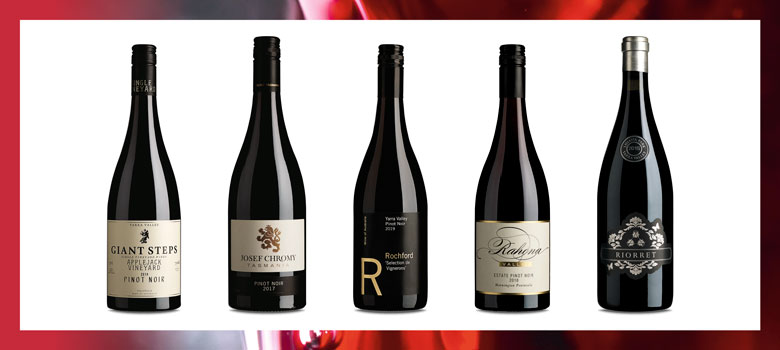
Giant Steps Applejack Vineyard Pinot Noir 2018
Yarra Valley, RRP $60
Fruit from the Applejack Vineyard benefits from its high altitude, as well as volcanic, basalt-based soils. These influences, combined with considered winemaking, have produced a gorgeous Pinot with a funky nose of red berry and smokey oak. Bright cherry and raspberry flood the palate with understated oak adding a creamy element, dried herb notes and a long, supple finish.
Josef Chromy Pinot Noir 2017
Tasmania, RRP $38
This wine was named the best Pinot Noir in Australia at the 2019 KPMG Sydney Royal Wine Show – a credit to both this incredible producer, and to the world-renowned quality of Tasmanian Pinot Noir. Sweet dark cherry fruit and toasty oak aromas introduce a palate of concentrated varietal fruit and creamy oak with just the right amount of whole bunch spice. It delivers cherry, plum and vanilla, giving richness and depth and fine tannins feathering onto the finish.
Rochford Selection de Vignerons Pinot Noir 2019
Yarra Valley, RRP $30
Rochford Wines has become a showpiece of the Yarra Valley, with its superb wines handcrafted using fruit sourced from four exceptional vineyards. Their 2019 Pinot Noir is medium purple in the glass with aromas of juicy dark berries with hints of confectionery and spice. It's light-bodied with strawberry, cherry and blood plum, long, juicy acidity, fine tannins and a crisp finish.
Rahona Valley Pinot Noir 2018
Mornington Peninsula, RRP $50
Rahona Valley, a boutique producer, pride themselves on adhering to the Burgundian tradition of densely planted vines to ensure maximum quality fruit. The result is beauties like this Pinot Noir with its fine, fragrant nose of strawberry, dark cherry, earth, white pepper and cedar oak. With a juicy core of cherry and strawberry, it displays fleshy and silken tannin sweetness, lovely cedary oak and a refreshing backbone of acidity.
Riorret Lusatia Park Pinot Noir 2018
Yarra Valley, RRP $45
This wine is made by De Bortoli from their extraordinary Lusatia Park Vineyard located at Woori Yallock in the upper reaches of the Yarra Valley. From the 2018 vintage comes a bright Pinot with a subtle, perfumed nose of strawberry, cranberry, vanilla bean and stalky spice. Elegant with strawberry and cranberry fruit depth, it shows savoury stalk and herb notes, well-judged vanillin oak and a long, silken mouth-feel.
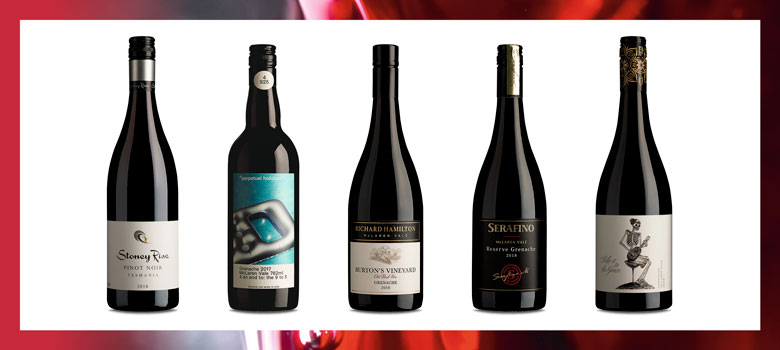
Stoney Rise Pinot Noir 2018
Tasmania, RRP $29
While Stoney Rise is named after a South Australian surf break, this Pinot Noir, made by Matthew White's dear friend Joe Holyman, is unmistakably Tasmanian. It has a fresh nose of field strawberry with fine barrel spice. The palate is long and elegant with a mix of dark cherry and strawberry, a supple and velvety tannin foundation, lovely astringent acidity and savoury oak support. Very youthful and energetic!
Big Easy Radio Perpetual Holidaze Grenache 2017
Great Southern, RRP $28
Big Easy Radio view Grenache as an essential ingredient in giving up the 9-to-5 treadmill. But while the dream of a perpetual holiday might be just that, this delicate ruby red-coloured wine provides a brief escape with its heady aromas of Cherry Ripe and strawberry with hints of earth and new leather. Powerful yet gentle, it's velvety with ripe cherry and strawberry, terrific umami and glossy charm.
Richard Hamilton Burton's Vineyard Grenache 2018
McLaren Vale, RRP $40
This Grenache is named after pioneering McLaren Vale viticulturist Burton Hamilton and befitting his spirit, it’s described as “a true expression of McLaren Vale terroir.” It presents a mix of raspberry and anise aromas with curranty, spice-laden power. Delivers mouth-filling varietal concentration and depth, while the tannins are deep and firm, and the finish long and polished.
Serafino Reserve Grenache 2018
McLaren Vale, RRP $60
Serafino’s Reserve Grenache, sourced from three premium McLaren Vale vineyards, follows on from their Trophy-winning 2017 vintage and promises to be just as impressive. It’s medium density red in the glass with a pretty nose of dark cherry, chocolate and cedar spice aromas. The charm continues on the richly flavoured palate with its savoury mix of earthy red fruits, mocha oak, white pepper spice, red berry-like acidity and fine yet deep tannins.
Take it to the Grave Grenache 2018
McLaren Vale, RRP $20
This joint venture between Nicholas Crampton and South Australian winemaker Corey Ryan was created to deliver interesting and rewarding wines while challenging a few established rules and preconceptions. Their Grenache shows a fragrant lift of raspberry, plum, baked beetroot and white pepper aromas. The palate presents a fleshy mix of dark fruit, attractive savoury spice, firm tannins and lovely acid crunch.
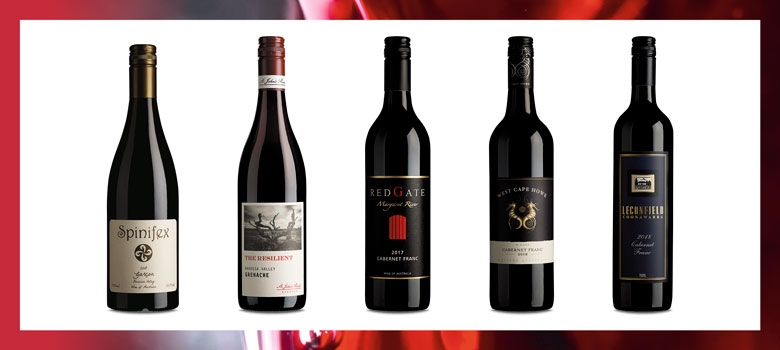
Spinifex Garçon Grenache 2018
McLaren Vale, RRP $45
Featuring 90 percent Barossa and 10 percent Eden Valley fruit, this is the third release of the Garçon. The nose is resplendent in aromas of raspberry, dark cherry, plum, white pepper, wild herb and charcuterie, while the medium-bodied palate has impressive flavour depth showing jubey red and black fruits, attractive pepper, dried herb and stalky complexity, fine tannins, supple acidity and a spicy finish.
St John's Road The Resilient Grenache 2018
Barossa Valley, RRP $22
The Resilient Grenache is named after the fact that the Barossa is not only home to some of the world’s oldest Grenache vines, but that this variety has also weathered years on the bottom rung of the fashion ladder. Sourced from four premium Barossa vineyards, this is a delicious wine in the modern fruit-focused style with a seductively silken texture driving the fine mix of red fruit, slippery texture and a moreish finish.
Redgate Cabernet Franc 2017
Margaret River, RRP $40
Redgate has a great affinity with Cabernet Franc, counteracting its tendency for vigour by hard pruning to reduce yield and increase colour and flavour. Their 2017 vintage features smokey dark berry fruit, strong dried herb and graphite aromas. Flavours of crunchy blackcurrant and raspberry fruit feature along with toasty oak, tobacco and dried herb complexity, firm tannins and fresh acidity.
West Cape Howe Black Label Cabernet Franc 2018
Great Southern, RRP $22
West Cape Howe has access to some of the oldest vineyard resources in Western Australia, including Great Southern – the home region for this Cabernet Franc. Exuding aromas of redcurrant, cassis, red capsicum, tobacco and gun smoke, it's a medium-bodied expression of the variety that's bright, fresh and lively showing red and black fruit core depth, fine tannins and fresh acidity. A juicy and well-balanced wine.
Leconfield Cabernet Franc 2018
Coonawarra, RRP $29
For Leconfield, the appeal of Cabernet Franc lies in the fact it does not have the firm tannins that often characterise Cabernet Sauvignon. Hailing from an ideal Coonawarra vintage, this single vineyard expression has a nose of blackcurrant, redcurrant, bay leaf and graphite. The palate delivers ripe blackcurrant with tart red berry-like acidity, bay leaf and new leather notes, fine tannins and a touch of gun smoke.